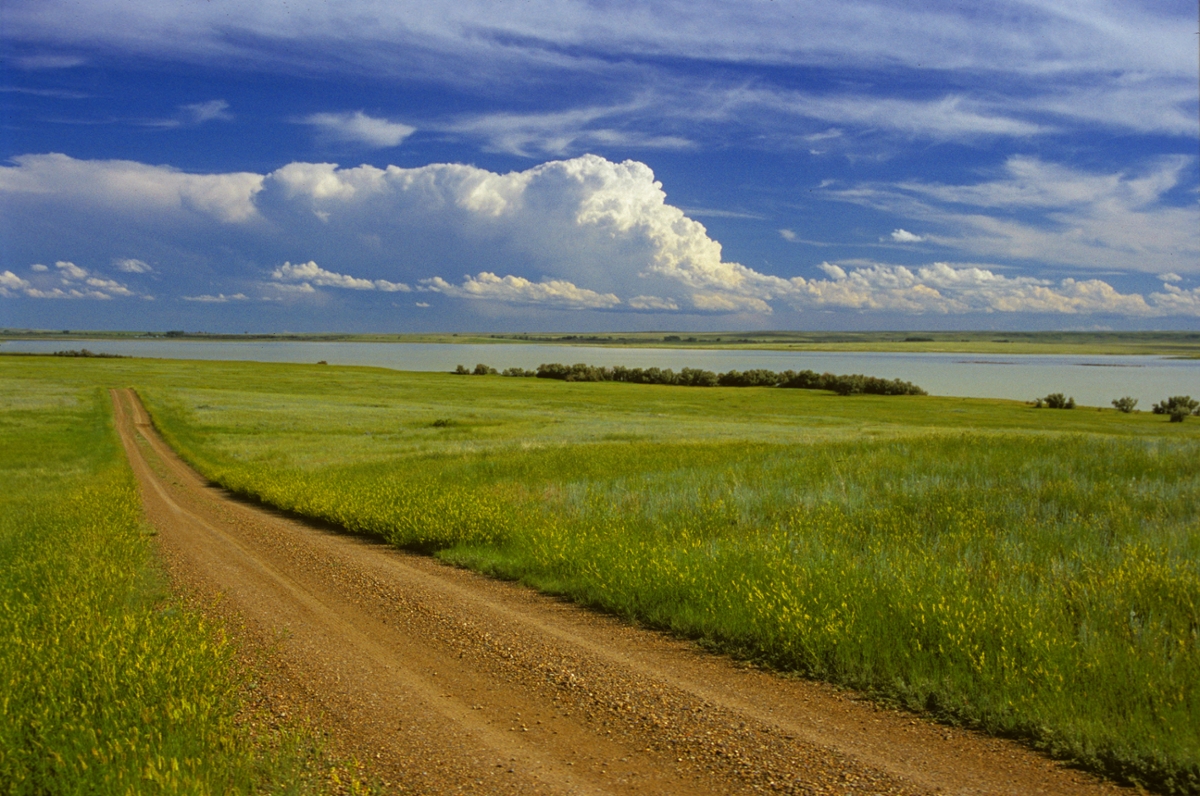Bowdoin Wildlife Refuge Offers Incredible Haven for Wildlife
 A road winds across the Bowdoin National Wildlife Refuge near Malta. (Photo by Rick and Susie Graetz)
A road winds across the Bowdoin National Wildlife Refuge near Malta. (Photo by Rick and Susie Graetz)
Fifteen thousand years ago, after leaving its home base in northern Canada, a runaway continental ice sheet passed through these parts, scouring the landscape and moving the Missouri River 50 miles to the south. The lakes that now make up the Bowdoin National Wildlife Refuge were once a horseshoe bend of the pre-glacier Missouri.
This north-central Montana wildlife haven, seven miles east of Malta, is part of a once incredibly rich animal kingdom frequented by the plains tribes, including the Blackfeet, Cree, Gros Ventres and Assiniboine nations. They hunted and gathered roots, berries and herbs here. Tipi rings found on the refuge are evidence of their passing.
In 1936, recognizing the wildlife values of the area, the federal government established the refuge under the joint management of the U.S. Bureau of Reclamation and the U.S. Fish and Wildlife Service. In February 1972, USWFS took over sole jurisdiction.
Prior to the establishment of the sanctuary, water levels of Lake Bowdoin and the surrounding ponds fluctuated wildly between spring runoff and the dry summers. The shallow water remaining through the summer months was hot and stagnant and frequently became infested with botulism, killing thousands of birds every season.
To help solve this problem, the Fish and Wildlife Service established a system of dikes designed to hold spring runoff and keep water levels as high as possible. An evaporation loss rate of 36 to 40 inches each year doesn’t help the situation, especially in drought years. A Milk River diversion at Dodson, about 25 miles to the west, reaches the refuge by way of a viaduct. Although they don’t always get as much volume as they want, refuge managers rely on their Milk River water rights to ensure adequate flow is available. Water levels still fluctuate, just not as dramatically.
Vanishing water creates alkaline deposits, another management issue on the refuge. Salts such as sodium, calcium, magnesium and potassium are leached from water when it dissipates in the warm dry air, leaving a white alkaline or salt residue on the earth. In the dry months, winds blow away the salts. In a strong gale, it may appear that the lakebeds are on fire as the light colored accumulations fill the air. During high water times, the alkaline buildup is flushed out. If it weren’t for nature’s compensating actions, the closed lake basins of Bowdoin would eventually become useless to wildlife.
Good management has created one of the best nature viewing areas in Montana. More than 230 different species of birds and waterfowl have been identified. Bowdoin also is considered Montana’s prime place to see pronghorn antelope in their natural habitat. Big-game hunting is not allowed, so the herd has natural age distribution. Big animals are evident.
Bowdoin’s upland native grasses are considered to be of extremely high quality as evidenced by the presence of the Sprague’s pipit and the Baird’s sparrow – birds that choose only the best.
Along with Medicine Lake National Wildlife Refuge, Bowdoin has the largest colony of white pelicans in Montana. Some of us who float prairie waterways call these birds “the river’s Air Force.” With their enormous black-tipped wingspans, they silently fly in military-like formation. At Bowdoin, they congregate and nest on the Pelican Islands.
Some years, in order to accommodate a growing population of nesting Canada geese, refuge managers create artificial islands. In winter, mounds of dirt are piled on the thick ice, and then spring melt allows the new “land” to form.
Habitat is defined as a place that provides a living creature with everything needed for survival, and the piping plovers find this haven to be good for their needs. However, at times it’s necessary to provide a man-made lair for these small birds. A sandy shoreline is too bare, so pebbles are spread on a beach to help camouflage the aerie from predators.
Bigger animals especially need adequate cover, and they find it here in the form of shelterbelts made up of tall grasses, shrubs and cattails. These protected areas also provide food for the many birds and mammals that remain throughout the cold months.
The names of all the neighbors who live here throughout the warm days are too numerous to mention. Included though in the population are double-crested cormorants, whitetail deer, great blue herons, ring-necked pheasants, sandpipers, sharp-tailed grouse, coyotes, osprey, an occasional bald eagle, all kinds of hawks, falcons, numerous ducks, tundra swan, loons, owls, the yellow-rump warbler and the yellow-billed cuckoo.
From the time the “transient residents” arrive for the summer until they gather in autumn to begin their southern sojourn, constant chatter fills the air. There is much to “talk” about and do as new life is created.
Early morning and late afternoon in the spring and fall are the best times to visit the Bowdoin National Wildlife Refuge. Its 15,500 acres can be seen via a 15-mile circular route. This special natural community is easily reached from Malta.
University of Montana | Department of Geography | Rick and Susie Graetz
